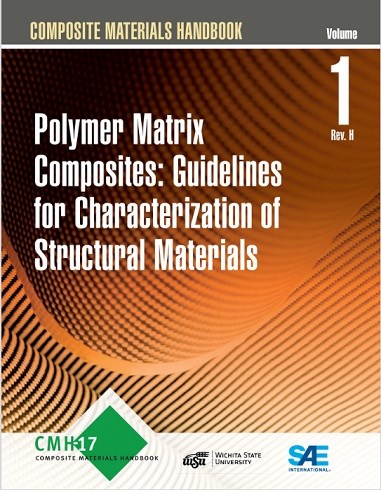CMH-17 publishes new revision of Volume 1 for “Polymer Matrix Composites”
Volume 1, which contains guidelines for determining information related to polymer matrix composites (PMCs), now features amended roadmaps and complete chapter revisions.

Composite Materials Handbook-17 (CMH-17), Volume 1. Photo Credit: WSU, SAE International
The Composite Materials Handbook-17 (CMH-17) recently published a new revision of Volume 1 for “Polymer Matrix Composites: Guidelines for Characterization of Structural Materials.” The new revision is available for purchase in print or digital format through SAE International (Warrendale, Pa., U.S.).
Volume 1 contains guidelines for determining the properties of polymer matrix composite (PMC) material systems and their constituents and properties of generic structural elements including test planning, test matrices, sampling, conditioning, test procedure selection, data reporting, data reduction, statistical analysis and other related topics. Volume 1 contains guidelines for general development of material characterization data and specific requirements for publication of material data in CMH-17.
Changes to Vol. 1 include updated roadmaps for use of Volumes 1-3 and complete chapter revisions for Guidelines for Property Testing of Composites, Matrix Characterization, Prepreg Material Characterization and Structural Element Characterization. New additions include High Load Rate and Dynamic Testing and Test Method Induced Variability in Comparing Two Groups.
The primary purpose of this volume is to document industry best practices for engineering methodologies related to testing, data reduction and reporting of property data for current and emerging composite materials. It is a critical tool worldwide for engineers designing and fabricating products made from composite materials (see “Material equivalence testing in shared composites databases”).
CMH-17, is a six-volume engineering reference tool that contains thousands of records of the latest test data for polymer matrix, metal matrix (MMC), ceramic matrix (CMC) and structural sandwich composites. It provides information and guidance necessary to design, analyze, fabricate, certify and support end items using composite materials. It also includes properties of composite materials that meet specific data requirements and guidelines for design, analysis, material selection, manufacturing, quality control and repair.
Wichita State University’s (WSU) National Institute for Aviation Research (NIAR) serves as secretariat for CMH-17, which holds regular meetings to write, edit, update, review and approve new sections of the handbook.














.jpg;maxWidth=300;quality=90)

